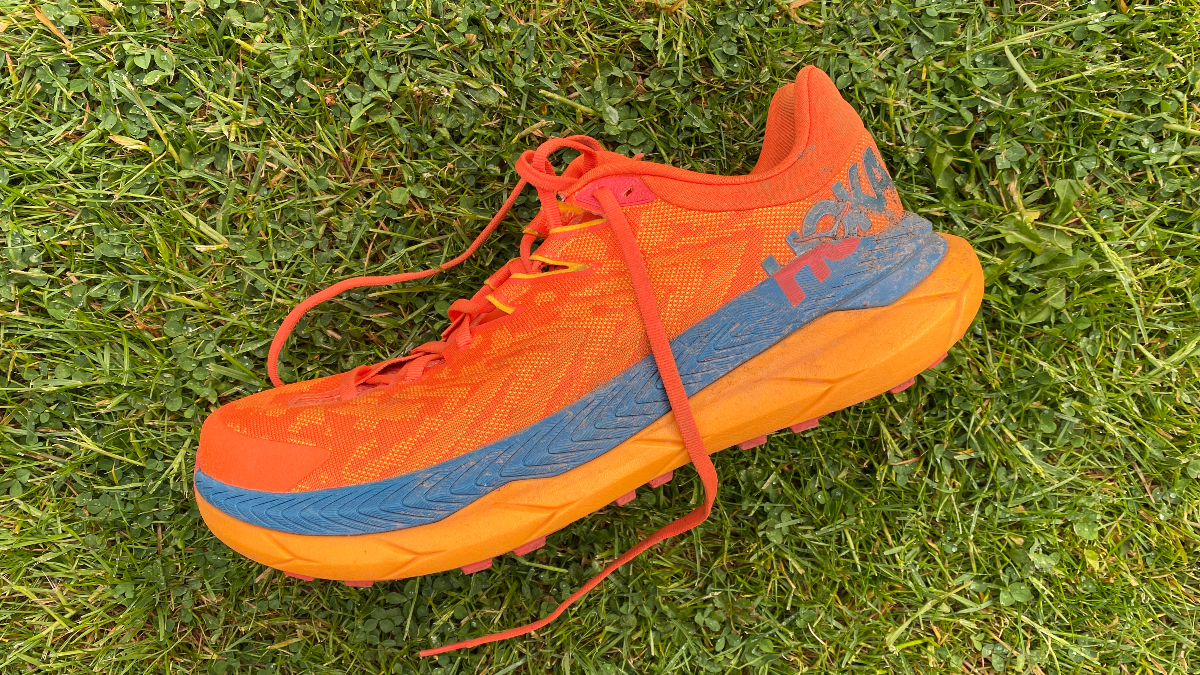Our Verdict
The Tecton X is another impressive option in Hoka’s excellent range of trail-racing shoes, but it’s not the game-changer many hoped for.
For
- Works well on a variety of trails
- Stable and speedy
- Comfortable for long runs
Against
- Expensive for a trail shoe
- More lightweight racers available
You can trust Coach
Carbon-plate running shoes might be de rigueur on the road-racing scene now, but they’ve yet to become commonplace on the trails. One reason for that is the propulsion they provide doesn’t kick in if you’re not on flat, hard surfaces, and another is that the plates are often paired with high stacks of soft foams in road shoes, which would make a trail shoe dangerously wobbly.
The North Face Flight Vectiv was the first carbon-plate trail shoe I tested and while it earned itself a spot in our round-up of the best trail-running shoes, it only shone on hard, relatively tame trails. It almost felt like a road shoe at times. The Hoka Tecton X is a proper trail shoe with an outsole that can handle a range of terrain, and with two carbon plates in its midsole it held a lot of promise.
Hoka Tecton X: Price And Availability
The Tecton X is available from Hoka and costs $200 in the US and £175 in the UK. That price is par for the course with carbon-plate road racers, but it’s a lot for a trail shoe with other top options from Hoka like the Speedgoat 5 and Zinal costing $155/£130 and $160/£140 respectively. That said, The North Face Flight Vectiv is similarly expensive at $199/£180.
It is available now on Hoka UK but not from Hoka US just yet, and will hit third-party retailers shortly.
Design And Fit
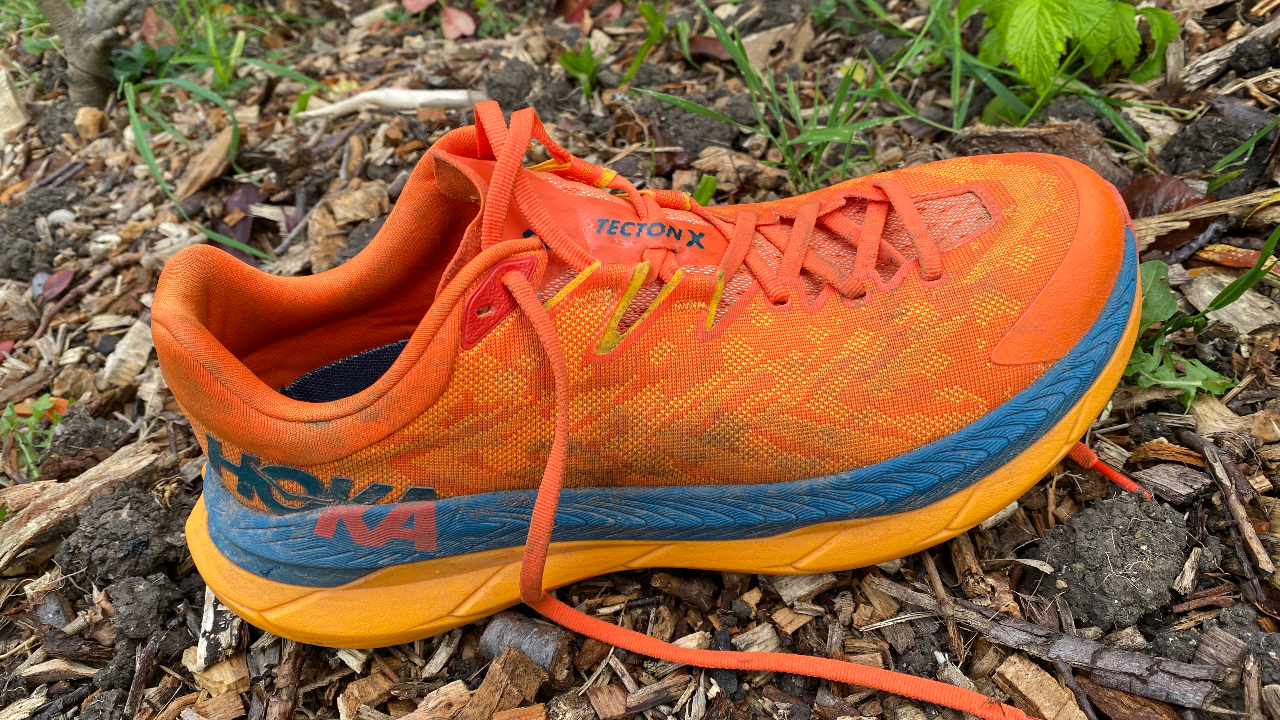
The most exciting part of the Tecton X is the tech in the midsole. The shoe has a dual-density Profly X midsole, with a softer layer of foam on the top and a firmer, more-responsive layer beneath.
Sandwiched in those foams are two carbon plates that run in parallel down the length of the shoe. By having two plates instead of one larger one the Tecton X is less rigid and works better on uneven, technical trails while still providing extra pop.
The upper is a jacquard mesh with a gusseted tongue. There is cushioning around the heel and a thin toe bumper to protect your feet a little, but the design prioritises keeping the weight down for racing rather than comfort and protection.
I found that the Tecton X fitted me well in my normal size, though I did note that my UK 9 was a US 9.5, rather than a 10, which it is with most shoes. Some may find the toe box a little snug, especially if you are planning to use the Tecton X for ultra distances.
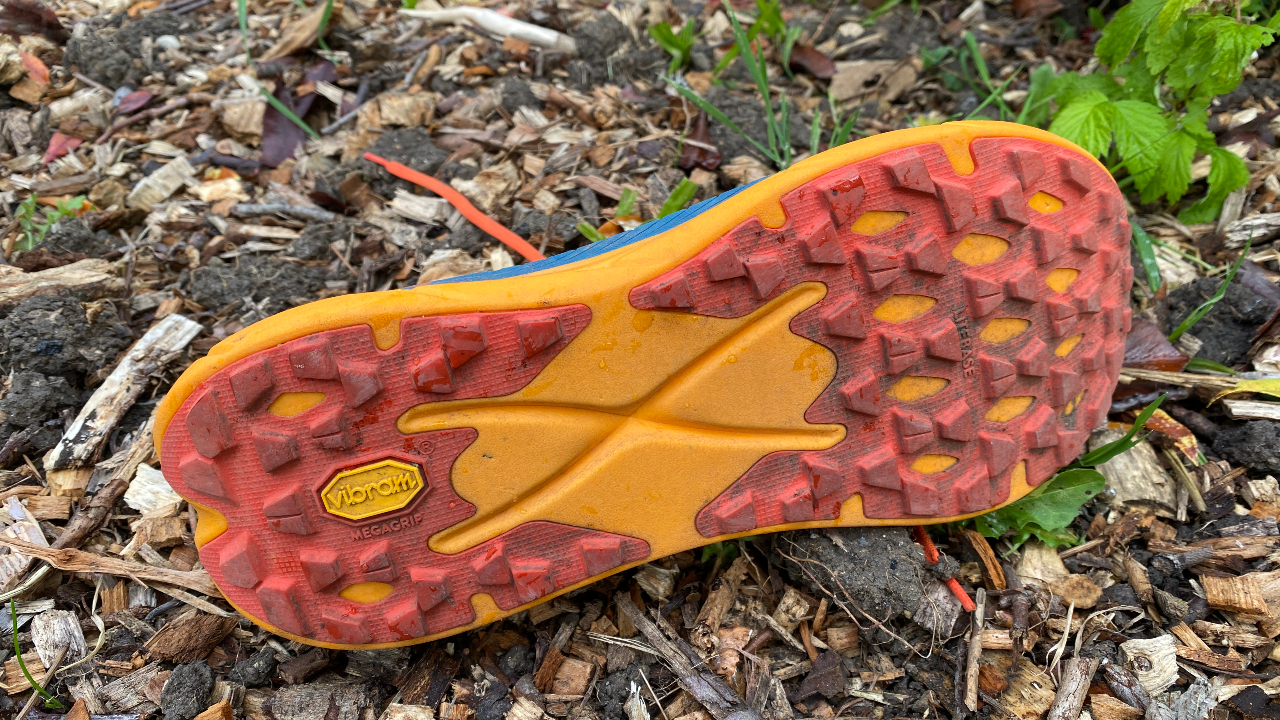
The shoe has Vibram Megagrip Litebase outsole with short, flat 4mm lugs. These are best suited to hard trails rather than soft ground, but do a solid job across most terrains. The lugs are confined to key areas in the heel and forefoot, with a lot of exposed foam in the midsole, another measure that helps keep the weight down.
At 260g (UK 9) the Tecton X is light for a trail shoe with this much cushioning. The shoe has a 4mm drop and a stack height of 33mm in the heel and 29mm in the forefoot for the men's shoe, and 31mm in the heel dropping to 27mm in the forefoot in the women’s shoe.
How I Tested This Shoe
I’ve run 65km in the Hoka Tecton X, covering a range of trails including well-kept forest paths, canal towpaths and muddy single-track. My longest run was 24km, and I have mixed up my paces in the shoe, with long stretches of fast running on hilly and flat trails.
Running Performance
When you first step into a top carbon-plate road racing shoe it’s apparent they are a different breed, but the Tecton X’s qualities take a little longer to reveal themselves. On my first run in the shoe – 90-minutes, where I ran on a mix of terrains – there were instances when it felt fantastic, but for the most it felt like a pretty standard lightweight trail shoe.
When it’s good, however, it’s very good. I think on every uphill during my runs in the shoe I found I was running faster than I thought, based on feel. And, when you do get a long stretch of harder, flatter terrain the plates come into play. During that first long run I ran a progression 5K along a canal towpath going from around 3min 40sec/km to 3min 28sec/km and while it’s not explosively fast it does roll you onto your toes nicely and has a punchy toe-off.
You generally need to be on harder trails to unlock that feeling. On one muddy run in the forest the Tecton X gripped well but I didn’t get much propulsion from the plates when I upped the pace. It’s the same on uneven ground – the Tecton X’s outsole can handle it, but don’t expect anything dramatic from the plates until you hit the flat stuff.
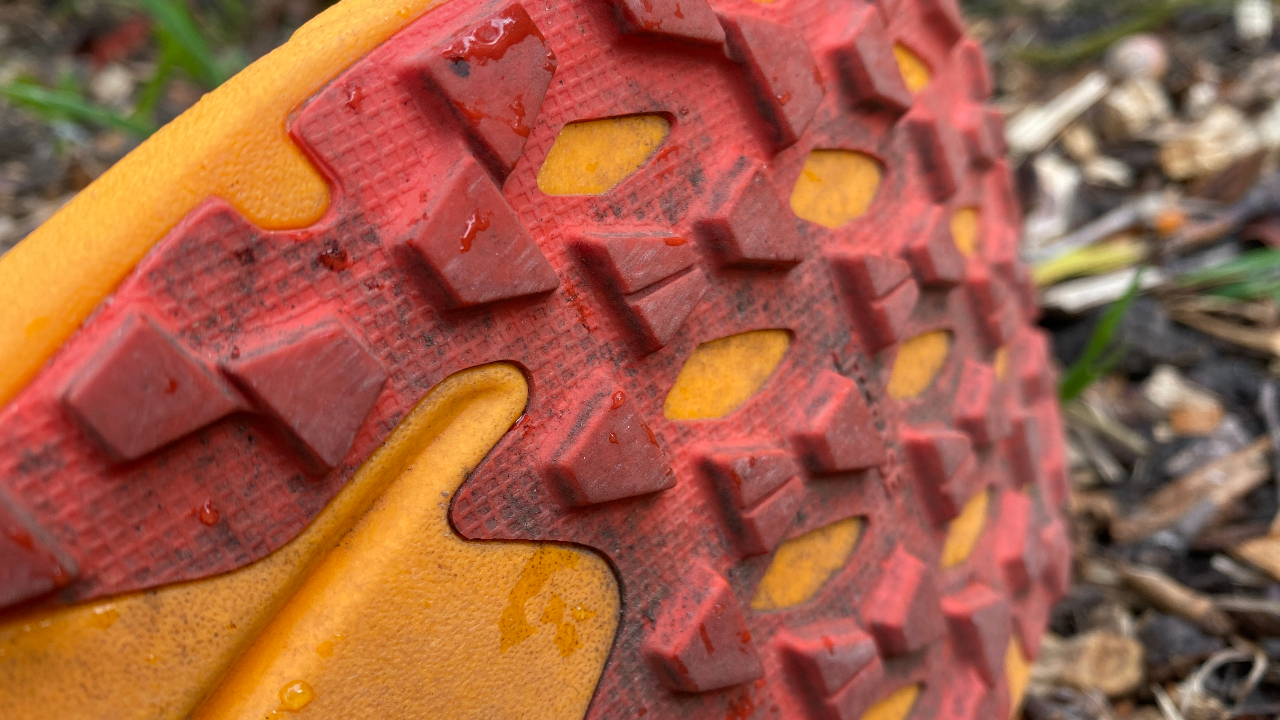
I found that the Tecton X was comfortable for long stretches on hard ground and even roads, but noticed that when trying to run fast on asphalt the sticky feel to the outsole detracted from the ride. In contrast, those lugs were excellent at finding purchase on dusty, gravelly tracks with a loose layer on top, where road shoes will slip a little on each step.
The Tecton X feels too firm to be truly enjoyable on purely easy runs, when I’d much prefer to have something like the Hoka Speedgoat 5 on my feet. I think the Tecton X will be an ultra-marathon racing option for some, but I think just as many would want a softer option for long events, with the Tecton X’s sweet spot perhaps being 20km-50km trail races.
Is The Hoka Tecton X Worth It?
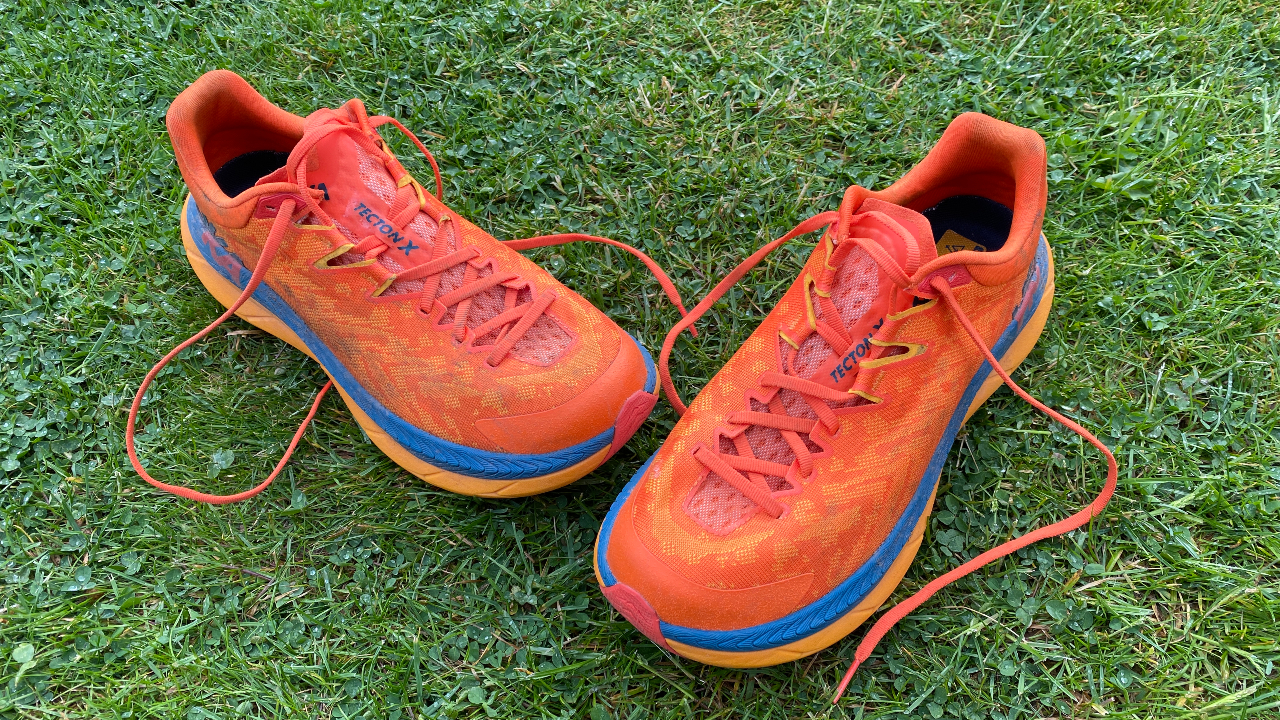
The Tecton X is a very good trail-racing shoe, but when you compare it with non-plated options like the Speedgoat 5, Hoka Torrent 2 or Adidas Terrex Speed Ultra, the performance gap is noticeable, but nowhere near as significant as with road-racing shoes. It’s worthwhile splashing out big money for a carbon road super-shoe if you’re focused on performance, but I’m not sure the Tecton X is worth spending such a large amount of money on, unless you are lining up events that play specifically to its strengths and have long stretches of relatively flat, hard ground where the carbon plates come into play.
I rate it as a better option than The North Face Flight Vectiv, which only works on harder ground, whereas the Tecton X can handle most trails because of the more impressive outsole. If you’re desperate to pick up a carbon-plate trail shoe, this is the one I’d suggest from the two I’ve tested. But I’d hesitate to say go and grab the Tecton X over the Torrent 2 if tackling shorter trail events or the Speedgoat 5 if going long.

Nick Harris-Fry is a journalist who has been covering health and fitness since 2015. Nick is an avid runner, covering 70-110km a week, which gives him ample opportunity to test a wide range of running shoes and running gear. He is also the chief tester for fitness trackers and running watches, treadmills and exercise bikes, and workout headphones.
